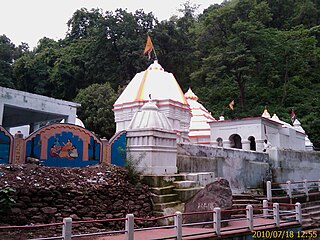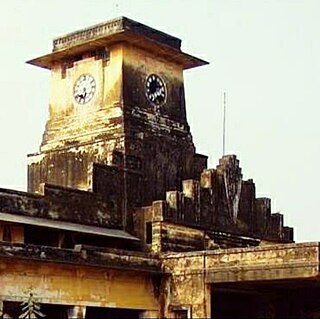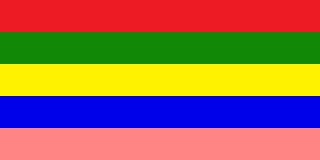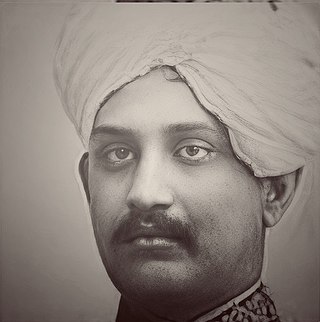Related Research Articles

Balangir District, also called Bolangir District, is a district situated in Odisha state of India. The district has an area of 6,575 km2 (2,539 sq mi), and a population of 1,648,997. The town of Balangir is the district headquarters. The composition of the land is predominantly rural. Other important big & small towns in Balangir district are Titlagarh, Patnagarh, Kantabanji, Loisingha, Saintala, Belpada, Tushra, Agalpur, Deogaon, Chudapali, Biripali, Bhalumunda, Bangomunda, Sindhekela, Turekela and Muribahal.

Boudh District is an administrative and a municipal district, one of the thirty in the Odisha, India. The district headquarters of the Boudh District is the city of Boudh.

Rewa State, also known as Rewah, was a Rajput princely state of India, surrounding its eponymous capital, the town of Rewa.

Dhenkanal State was one of the princely states of India during the period of the British Raj. The state is now referred to as Dhenkanal district, Odisha, with Dhenkanal town as its district headquarters.

The Imperial Legislative Council (ILC) was the legislature of British India from 1861 to 1947. It was established under the Charter Act of 1853 by providing for the addition of 6 additional members to the Governor General Council for legislative purposes. Thus, the act separated the legislative and executive functions of the council and it was this body within the Governor General's Council which came to known as the Indian/Central Legislative Council. In 1861 it was renamed as Imperial Legislative Council and the strength was increased.

Bastar state was a princely state in India during the British Raj. It was founded in the early 14th century by Annamaraja, a brother of the last ruler of the Kakatiya dynasty, Prataparudra II.

Bettiah Raj was the second-largest zamindari in the Bettiah region of Bihar, India. It generated annual land revenue rentals of more than 2 million rupees.

Alirajpur State was formerly a princely state of India, administratively under the Bhopawar Agency subdivision of the Central India Agency. The state covered an area of 2165 square kilometres, with a population of 50,185 in 1901 and its capital at Alirajpur. The average revenue of the state was Rs.100,000 in 1901.

Saraikela State also spelt Seraikela, Saraikella or Seraikella, was a princely state in India during the era of the British Raj, in the region that is now the Jharkhand state. Its capital was at Saraikela.

Maharaja Sri Rama Chandra Bhanja Deva was the Maharaja of Mayurbhanj State of India.
Sonepur, is the district headquarters of Subarnapur district of Odisha, has a special place on the political and cultural map of India since the pre-historic period. It is bounded on the north by Sambalpur district, on the south and the South-East by Boudh district, on the east by Rairakhol sub-division of Sambalpur district and on the west by the ex-state Patna.

Soroda Estate present day Sorada or Surada, was a zamindari in the North-Western side of Ganjam district of Odisha, India.

Udaipur State was one of the princely states of India during the period of the British Raj. The town of Dharamjaigarh was the former state's capital.

Kharsawan State, also spelt Kharsua or kharaswan, (Odia:ଖରସୁଆଁ)was a princely state in India during the era of the British Raj. The state had a privy purse of 33,000 Rs.It was one of the Odia Princely states of India during the period of the British Raj and the major language spoken in the area is Odia.
The Bhanja dynasty is a dynasty that originated in the northern and central regions of modern Odisha before the Gupta Empire became an imperial power. The dynasty, of ancient local Kshatriya lineage as documented by Hermann Kulke, succeeded the Vindhyatabi branch of the Nagas of Padmavati, who ruled from the Keonjhar district of Odisha and included Satrubhanja of the Asanpat inscription. The Bhanj later became feudatories of the Bhauma-Kara dynasty.
Samthar State was a princely state established in 1735 by Ranjit Singh in India during the British Raj. The state was administered as part of the Bundelkhand Agency of Central India. The state was ruled by Gujars and was the only princely state ruled by a Gujar dynasty entitled to a gun salute. Its capital, known then as Samshergarh, is located in a level plain in the Bundelkhand region crossed by the Pahuj and the Betwa Rivers.

Kanker State was one of the princely states of India during the period of the British Raj. Its last ruler signed the accession to the Indian Union in 1947.

Bir Mitrodaya Singh Deo KCIE, was Maharaja of Sonepur from 1902 until his death in 1937.
Pratap Rudra Singh Deo, was Raja of Sonepur from 1891 until his death in 1902.
References
- ↑ The Orissa Historical Research Journal. Superintendent of Research and Museum. 1999.
- ↑ Lethbridge, Sir Roper (1893). The Golden Book of India: A Genealogical and Biographical Dictionary of the Ruling Princes, Chiefs, Nobles, and Other Personages, Titled Or Decorated, of the Indian Empire. Macmillan.
- ↑ Encyclopaedia Indica: Princely States in colonial India. Anmol Publications. 1996. ISBN 978-81-7041-859-7.
- 1 2 Orissa (India) (1968). Orissa District Gazetteers: Balangir. Superintendent, Orissa Government Press.
- 1 2 3 4 5 Mazumdar, B. C. (1925). Chohan rulers of Sonpur.
- 1 2 3 4 Nāẏaka, Pabitra Mohana (2001). The Voice of Silence: Sonepur Durbar and Indian Cultural Traditions. Orissa Sahitya Akademi. ISBN 978-81-7586-058-2.
- ↑ Vadivelu, A. (1915). The Ruling Chiefs, Nobles and Zamindars of India. G.C. Loganadham.
- 1 2 Cotton, James Sutherland; Burn, Sir Richard; Meyer, Sir William Stevenson (1908). Imperial Gazetteer of India ... Clarendon Press.
- ↑ Who's who in India. Newul Kishore Press. 1911.
- 1 2 Department, India Foreign and Political (1909). United Provinces, Oudh, Bengal, Central Provinces. Office of the Superintendent of Government Printing, India.